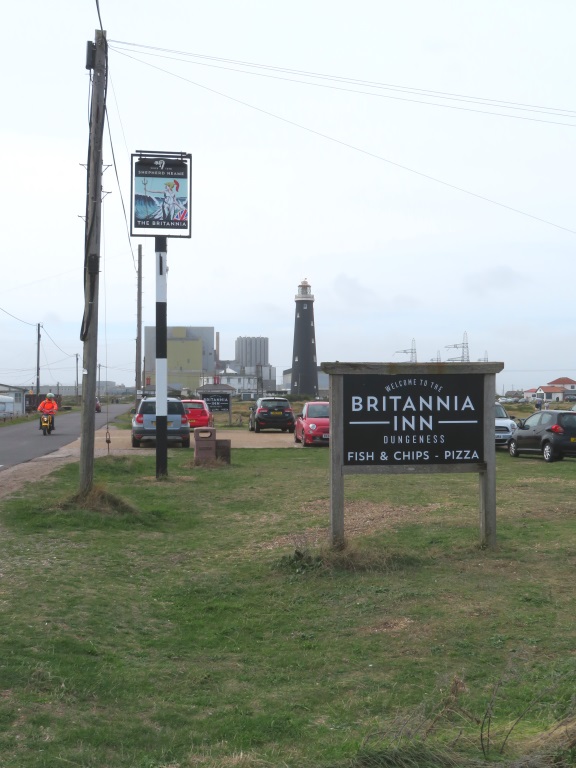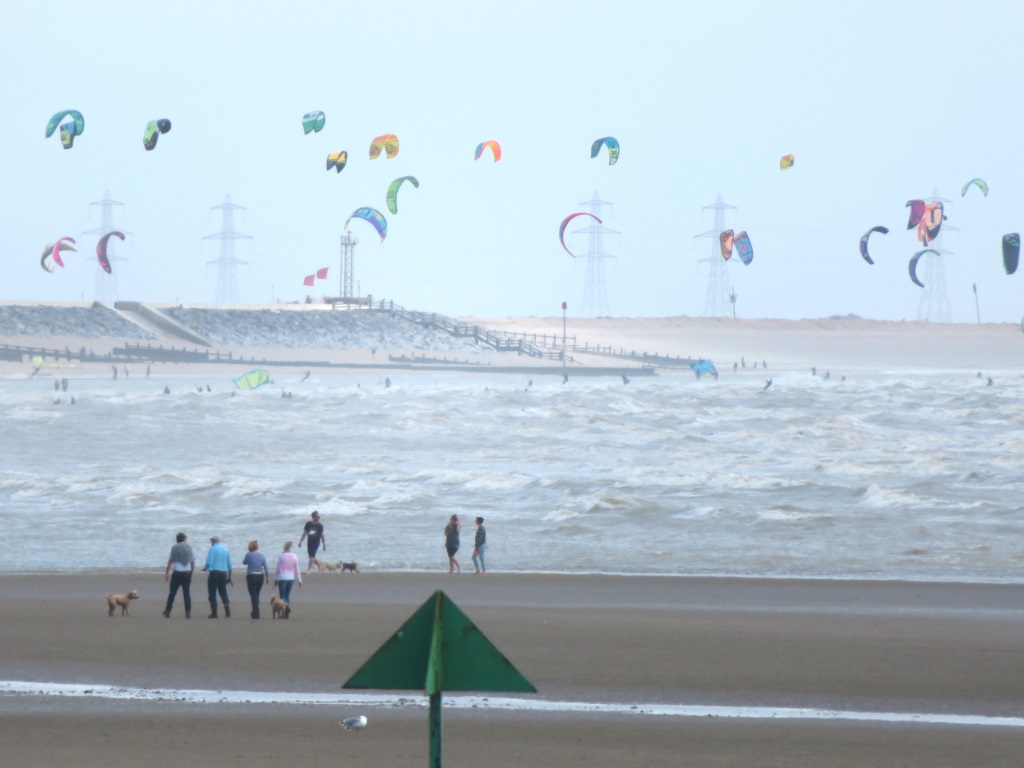Imagine a very breathy Matt Baker in a Countryfile opening segment... 'The windswept, shingle wilderness, at the end of this Kentish headland is something of a destination.', he says.
At least it is for those largely looking to lose themselves in the other-worldly or to look at the, unique to this location's, wildlife.
This will only take a couple of hours but not because that's all most can physically endure of this lug-chilling wind nor because of a particularly vast expanse, neither.

No, when the wooden walkway runs out, that's how long it takes to traverse 200-yards of this terrain. It really is a calf-killer, seriously.
The windswept, shingle wilderness is home to hardy fisherfolk, struggling artists and opters of isolation from the horrors of modern life.


Steadfastly defying the coastal elements, they inhabit humble, often ramshackle dwellings in a landscape described by some as 'Britain's only desert'. Well, not quite and Sir Walter Scott couldn't have romanticised it any better himself.
The rainfall might be below average but 60-odd annual centimetres hardly makes it the Sahara. A weatherproofed shed will set you back skywards of 200 grand-pounds and 90% of them are holiday homes anyway.
The handful who still trawl the ocean all live and enjoy the sea views at Lydd-on-Sea - thanks Chris , probably, and as for being isolated? It's only 20 minutes to Dymchurch and they've got a funfair there.

Dungeness as a destination is all Derek Jarman's fault, apparently. When the unconventional creator of the visual moved here in 1986, absolutely everybody else in London followed, everybody!
The garden of his cottage remains one of the main attractions and cleverly enhances the landscape with some colourful, imported shrubbery, not shown.
It's not shown because, well, not even the most basic form of homework was done beforehand.
The windswept, shingle wilderness isn't exactly exclusive, there are stretches all along the south coast and even up into Suffolk, but this one is the biggest. Dungeness is lent an additional, distinct identity, though, with a big power station as a backdrop and, get this, it's nuclear, yoinks!


Hot wastewater is deliberately discharged into the sea at an area known locally as the 'Boil' - thanks N Chadwick . It's not just the anglers it attracts, it also pulls in the birds and makes for a very biodiverse seabed, they say. Even now you know that, you're all still thinking of three-eyed fish, aren't you?
There are two power stations, actually, although Dungeness 'A' is in a phase of 'decommissioning' whatever that means exactly.
You can see the power station from absolutely everywhere including Jarman's garden and including the Britannia Inn's beer garden.

Dungeness' only pub, they claim, although the Pilot Inn is borderline. Their fish is a speciality although it's not thought to come cooked straight from the 'Boil'.
The windswept, shingle wilderness is home to a more familiar form of construction, the lighthouse, of course. The year 1961 this one and it's still doing some blinding work with the black and white stripes far, far superior to the routine, run-of-the-mill red.


Two lighthouses, actually, but the Edwardian original was being outshone by the power station, seriously, so that's why they pulled the plug in the '60s.
That and the fact it was now too far inland, thanks to the retreating sea, and you can see for yourself from atop although it's weekends only when not in season.
Three lighthouses, actually, but only the 19th-century base of this one remains in an accommodating kind of way.

Five lighthouses, actually, but the other two have long since been lost to Rodney, sorry, Romney Marsh.
You'll need to head six miles north and after the café and gallery, there's access to an area of the much larger 100-square miles of marshland.
This is where people actually live and work and the village of St Mary in the Marsh is as beguiling as it sounds, probably. Other highlights include the Church of St. Mary the Virgin, some bits of which are 12th century, it says here.
The windswept, shingle wilderness attracts one million annual visitors, they say, although it's suspected that was part of the pitch for the recent sale of the Dungeness Estate.
That didn't include the railway, though, and not just any old railway, the world's smallest public railway, no less.

At least it would be if that were true. This 15-inch gauger did hold the title from its opening in 1927 but only until 1982 when one opened in Norfolk nearly five inches narrower.
It's not known how many of the million choo-choo it in from Hythe but there's a fair few of them today clogging up the café, if not the platform.

This stretch is a five-mile extension south from New Romney and took less than a year to complete with the trackbed already suitable thanks to the shingle. It was requisitioned by the military during World War II when they needed to know just who was shelling what on the seashore but it was up and chuffing again by 1947.
Laurel and Hardy, no less, cut the ribbon at the reopening ceremony and the Sons of the 'Britain's only' Desert were, no doubt, just passing through on their Way out West to... Camber Sands.
Next to the station is a colourful hut serving local ales to be supped outside, when in season. It's an outlet for the Romney Marsh Brewery, a crafty looking bunch complete with Courier font.

Careful now and don't top up too much, there aren't any tiny lavs on the hour-long chug back to Hythe.
Camber Sands is a small, proper-old-skool seaside resort - thanks Robin - with a big holiday park and not so much of the windswept, shingle wilderness that's become accustomed to.

More would like to be told but there's a stern-looking lady in a booth who wants £1.50 for an hour's parking and the rain's just started to come in.
That's not seen off some of the nutjobs who come in their numbers to do some para-aqua-surf-fly-sailing, or something, off the substantial sands and no, it's not known if they do it at Waikīkī.
It turns out to be called Kiteboarding and these beginners haven't quite got the bottle, yet, for Beachy Head.


Like Jarman's garden, another thing not seen is what's left of some experimental 1930s concrete - thanks Julian - back near Lydd.
These 'Acoustic Mirrors' were an early form of enemy aircraft detection and they're out of bounds behind a caravan park. It looks like you can get quite close, just like they did before somebody went and invented radar.
Meanwhile, back at the windswept, shingle wilderness, it protects the southern part of Romney Marsh with just the occasional breach keeping the salt marsh topped up.

Sort of the start of Denge Marsh this, actually, and it comes as no surprise to learn it's a designated Site of Special Scientific Interest and, as should be known by now, they don't hand them awards out willy-nilly.
As well as being a Designated National Nature Reserve, it's also a Special Protection Area and Special Area of Conservation and that makes for an unplayable hand in Conservation Poker.
It's home to a third of all plant species in the UK including a few orchids you're unlikely to see elsewhere. It's all a riot of colour in summer, they say, but that might not be fully appreciated what with not really being botanical types.
Not unless, that is, you're talking about a clear, glass bottle with 'London' or 'Plymouth' printed on it.
Not far from the windswept, shingle wilderness is the RSPB™'s, get this, oldest nature reserve, no less. Opened in 1930 and comprised of the now-familiar terrain but peppered with watery pits left by the extracted gravel.

Twitchers were jerking furiously at the sight of an Acadian flycatcher back in 2015 and 20 years ago, the egret was just as rare a sight. The great white in particular with the little less so, they no longer get people that excited but look!
Here's a slightly out-of-focus cattle egret and these, literally, get a great big tick, rarity-wise.

They hang around with the herds and no, not for that reason, splat! They feed on the insects disturbed by the hooves of the clumsy ungulates and sightings of them are becoming increasingly frequent.
Let's just hope they don't move down to the 'Boil' when, in another 20 years, they'll all be six-foot-tall with lasers for eyes.
They'll still be called cattle egrets, though, but that's because they now eat them. Whole!


